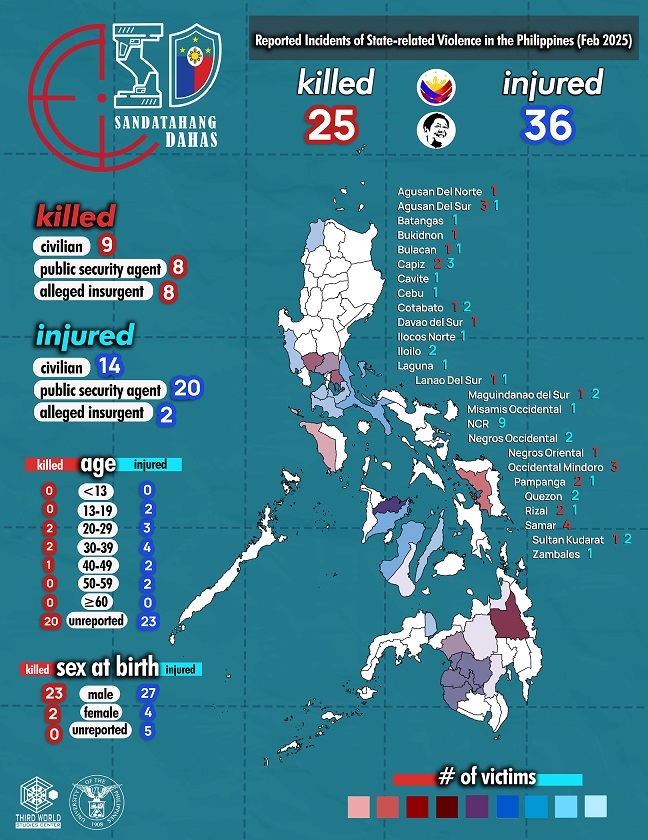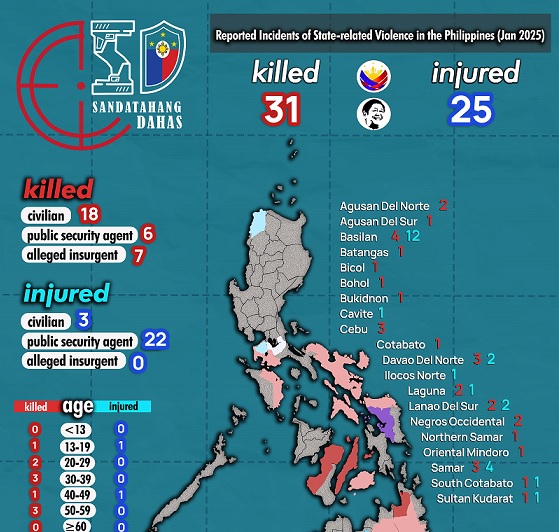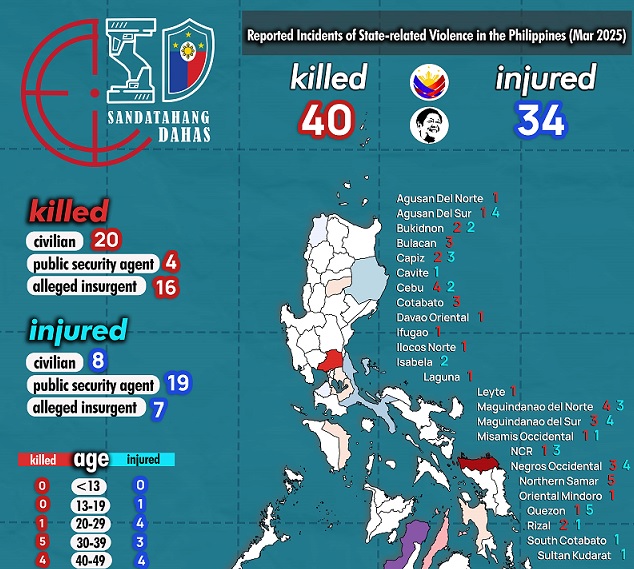Violence involving armed government personnel registered an increase while the police continue to lead in the killings of civilians who are subject of their operations, monitoring by Sandatahang Dahas’s for February 2025 showed.
In February this year, there were 61 recorded cases of state-related violence (25 killings, 36 injuries) compared to 56 last January (31 killings, 25 injuries).
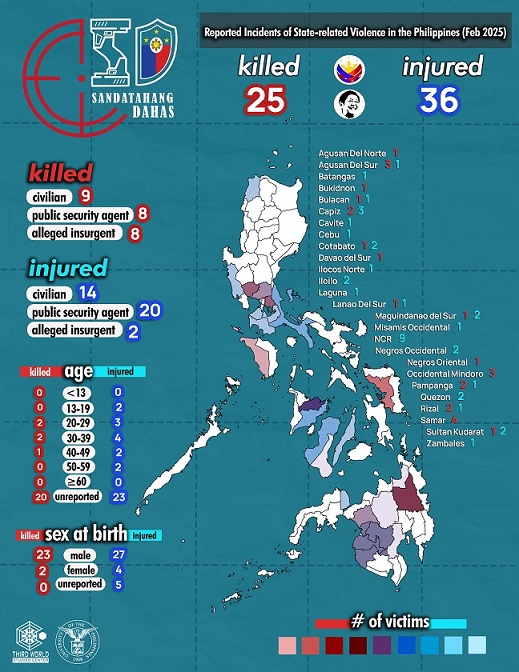
The Sandatahang Dahas is a monitor of the UP Third World Studies Center that records “killings and injuries caused by and inflicted on gun-bearing members of law enforcement organizations or a public security agent in the Philippines.”
The monitor found that the police were responsible for 10 killings (eight civilians killed during operations and two police officers killed by two other police officers); the Armed Forces of the Philippines (AFP) for nine (eight alleged insurgents and an army personnel killed by a member of the Citizen Armed Force Geographical Unit [CAFGU]); a combined team from the police, the military, and the Philippine Drug Enforcement Agency (PDEA) killed a drug den operator; alleged insurgents killed three members of the Philippine Army; and unidentified assailants killed two CAFGU members.
The most prominent among those killed by the military was Myrna “Maria Malaya” Sularte, leader of New People’s Army (NPA) in Caraga, secretary of the NPA-Northeastern Mindanao Regional Committee, and member of the political bureau of the Communist Party of the Philippines (CPP). Sularte was killed in a clash with the Army’s 901st Infantry Brigade in Brgy. Pianing, Butuan City after being under surveillance by the said military troop since Jan. 29, She was also the wife of the late NPA’s National Operations Command (NOC) chief, Jorge “Ka Oris” Madlos, who died in a battle with government forces in October 2021.
The other seven casualties in the military’s counter-insurgency operations were recorded in Samar, Sultan Kudarat, Negros Oriental, Agusan del Sur, and Capiz.
The family of Peter Agudes, an alleged insurgent that the military killed in Brgy. Minan, Tapaz, Capiz denied the military’s claim that he was a member of the NPA and doubted that he was killed in an encounter. Similar denials were made by the families of other alleged insurgents killed by the military.
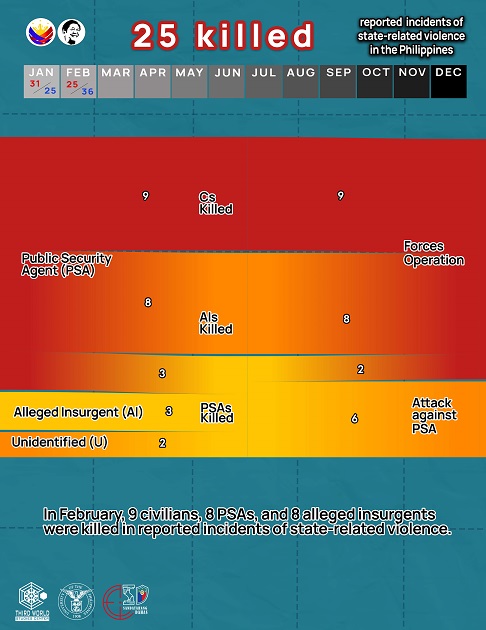
In its continuing anti-insurgency operations, the Philippine Army suffered three casualties. Two were killed in encounters with the NPA in Samar and Occidental Mindoro; one in an ambush by the NPA in Agusan del Sur.
Unidentified armed men abducted and shot dead 2 CAFGU members on a bridge in Occidental Mindoro due to an alleged land dispute.
The police, on the other hand, killed 8 civilians. These included two members of a robbery group in Angono, Rizal; a robber during a hot pursuit in Pangantucan, Bukidnon; a carnapper in Davao City; a snatcher in Angeles City; a drug pusher in Calbayog City, Samar; a killer in San Jose Del Monte, Bulacan; and another murder suspect in Matalam, Cotabato.
The police were also killing each other. In Angeles City, Pampanga, a policewoman killed her husband who was also a police officer. In a jealous rage, a policewoman killed another policewoman inside their office in Marawi City, Lanao del Sur.
In Jamindan, Capiz, a CAFGU member hacked to death an army sergeant.
In all, nine civilians died in reported violence related to armed state actors; eight among the ranks of the police and the military (two were killed in anti-insurgency operations and six in other attacks); and eight were alleged insurgents.
The fatalities in February were mostly male; only two were female.
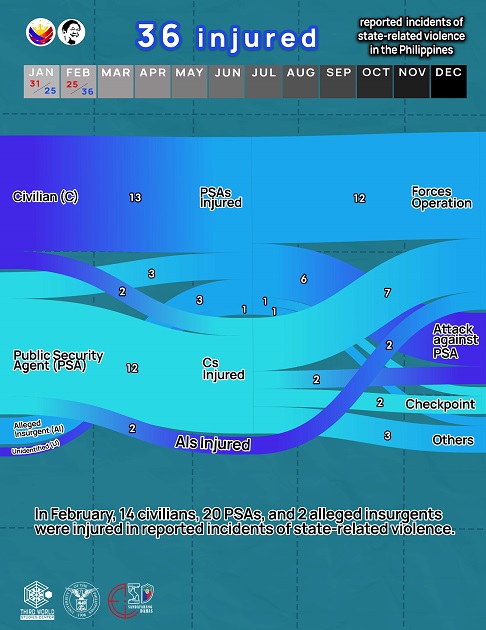
Of the 36 cases of injuries that Sandatahang Dahas recorded, 17 were committed by armed government personnel, 15 by civilians, three by alleged insurgents, and one by an unidentified assailant who shot and wounded an off-duty army intelligence officer in Radjah Buayan, Maguindanao del Sur.
Alleged insurgents wounded two soldiers in an encounter in Sultan Kudarat and a CAFGU member in an ambush in Agusan del Sur.
In 15 instances, civilians have injured the police and fellow civilians in the course of resisting an operation or fighting the police off in an encounter. In Brgy. Osias in Kabacan, Cotabato, for example, two civilians were wounded at a checkpoint when the suspected criminals that the police were pursuing earlier threw a grenade under a police vehicle.
Of the 17 cases of injuries caused by armed state actors, 13 were committed by the police, three by the military, and one involved the combined forces of PNP, AFP, and PDEA. These injuries were mostly suffered by the civilians. Sometimes, the civilians that the armed personnel managed to injure are from their own family. In Brgy. Ayungon, Valladolid, Negros Occidental, a corporal of Malay Municipal Police Station in Aklan shot and injured his wife, a 37-year-old elementary teacher who just recently gave birth to their child.
And not all injuries inflicted by the police were due to legitime police work. In Taguig City, ten police officers served a fake warrant of arrest to a woman who had been arrested before for her involvement with illegal drugs. While serving the warrant, the officers punched her son. When she and her daughter were forcibly taken to the police vehicle and they noticed that the police officers did not stop at the barangay hall, fearing that they were being kidnapped, they jumped out of the vehicle, resulting in her daughter’s head injury. In Caloocan, two residents were injured by stray bullets as a gunfight broke out between a wanted former police officer and those deployed to arrest him.
In a combat operation of the Philippine Army in Brgy. Minan, Tapaz, Capiz, two NPA members were wounded.
If the police and the military have caused most of the injuries, they were also mostly the ones in the receiving end of bodily harm. Twenty of them were injured, mostly by civilian actors. Twelve of their members were injured during operations, six in various attacks, and one while manning a checkpoint. There was also the isolated incident of a policeman who was accidentally shot while teaching gun proficiency at the Philippine National Police Academy.
Fourteen injuries were recorded among civilians: seven during police operations, two in an attack against the police, two at a checkpoint, two during an incident of police officers serving a fake warrant of arrest, and one shot by her police husband.
Of the 36 reported injuries from state-related violence this month, four involved females, 27 males, and five cases where the sex of the person was unreported.
The operations of the police and the military and allied government agencies, like the PDEA, remain the primary casualty-inducing incidents, leading to the death of 19 individuals and the injury of 21 others. Attacks against the police and the military, on the other hand, accounted for six fatalities and eight injuries, making it the second most frequent cause of casualties.
The February 2025 data reveal a shift in the geographic distribution of violence. While Mindanao still continues to report the highest number of fatalities, Luzon now records the most injuries. Unlike January, where the data pointed to a distinct epicenter of fatalities and injuries, February reports a more scattered yet persistent landscape of state-related violence.
Mindanao still bears a significant share of violence, with 10 killed and nine injured. Provinces such as Agusan del Sur, Sultan Kudarat, Maguindanao del Sur, and Cotabato report multiple casualties, reinforcing the region’s ongoing struggles with armed insurgency and political instability. In particular, Agusan del Sur records the highest number of fatalities in the island with three killed and one injured, while Sultan Kudarat, Maguindanao del Sur, and Cotabato each report one killed and two injured. For the longest time, these provinces have been battlegrounds for various armed groups, such as the NPA, and data suggest that the conflict remains unresolved. Other provinces, such as Lanao del Sur, Davao del Sur, Bukidnon, and Agusan del Norte, each report 1 killed.
Luzon, however, records the highest number of injuries this month, with eight killed and 19 injured. Unlike in January, when violent incidents in Luzon were sporadic, February’s data shows a troubling rise in casualties across multiple provinces, especially in the capital. The National Capital Region (NCR) alone accounts for nine injuries, suggesting an increase in urban violence. Provinces such as Occidental Mindoro, Pampanga, and Rizal report multiple casualties, with Occidental Mindoro recording three killed, and Pampanga and Rizal each with two killed and one injured. These cases highlight the diverse nature of violence in Luzon, where killings may stem from a combination of crime, insurgency, or political motives, especially now that the election period has officially started. Other affected provinces include Bulacan, Batangas, Cavite, Ilocos Norte, Laguza, Quezon, and Zambales, all of which record at least one incident of either a fatality or an injury. The broader spread of violence in Luzon suggests that while Mindanao remains a volatile region, the north is not immune to increasing violence.
In Visayas, the pattern of violence remains more concentrated in specific provinces. February’s data report seven killed and nine injured, with Samar emerging as the most affected province, recording four killed. The history of insurgency-related clashes in Samar suggests that these deaths are linked to ongoing armed conflict. Capiz follows with two killed and three injured, while Negros Occidental and Negros Oriental continue to report casualties related to agrarian political violence, reinforcing this problem in these areas. Iloilo and Cebu also report injuries, with Iloilo recording two and Cebu reporting only one.
The authors are interns of the UP Third World Studies Center. To learn more about Sandatahang Dahas, visit its website: https://dahas.upd.edu.ph/sandatahang-dahas/ and for the latest updates, follow the Dahas Project in these social media platforms: https://x.com/DahasPH, https://www.instagram.com/dahas.project/, https://www.threads.net/@dahas.project, and https://bsky.app/profile/dahasph.bsky.social.
